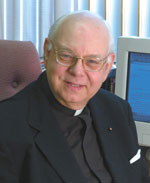Sixth Sunday in Ordinary Time / Msgr. Owen F. Campion
The Sunday Readings
 The first reading for this weekend comes from the Book of Leviticus.
The first reading for this weekend comes from the Book of Leviticus.
In sequence, Leviticus is the fourth book in modern translations of the Bible. As such, it is part of the Pentateuch.
The Pentateuch includes the five books of the Bible attributed to Moses. These five books are the Torah.
The Pentateuch forms the fundamental law and philosophy of Judaism, both in current understandings and ancient practices as well.
In this reading, God speaks to Moses and to Aaron, the brother of Moses. The topic is leprosy.
Today, it is not known whether these references to leprosy in the Scriptures referred to actual leprosy, which is now called Hansen’s disease, or to some other illness. However, regardless of the exact scientific nature of what the ancients called leprosy, this health problem was chronic and severe.
An entire social system developed around the disease. Victims were outcasts. They suffered being shunned by society, and also had to forage for food and search for shelter.
Ancient Jews would never blame God for the fact of such a serious malady. God was regarded as good, loving and merciful.
The ancient Hebrews saw human sin as ultimately the cause of all earthly misery.
St. Paul’s First Epistle to the Corinthians, this weekend’s second reading, includes the great Apostle’s counsel that Christians should do everything with the intention of glorifying God.
He admonished the Christians of Corinth never to offend either Jews or Gentiles. Paul urges the Christians to follow his example because Paul says that he imitates Christ.
The reading therefore sets Christ as the example, and insists that believers must follow the example of the Lord in their lives.
For its last reading, the Church gives us a passage from the Gospel of St. Mark.
In this reading, a leper approaches Jesus, pleading for a cure. Jesus cured the man, and the Lord was “moved with pity,” according to Mark.
This cure came when Jesus touched the man. As an aside, but nevertheless instructive, symbolic touching is very important in the liturgy. Touch creates contact and enables transference.
During ordinations, the ordaining bishop lays his hands upon the candidates to be ordained as a bishop, priest or deacon. At weddings, the bride and bridegroom hold each other’s hands as they say their vows.
Jesus transmitted the healing power of God to the man through this touch. Then Jesus spoke the miraculous words of healing.
The Lord ordered the man to go to the priests. The man had been exiled from the community because of his illness. If the priests saw that he was free of disease, they would admit him to society again.
The reading closes by noting that great crowds pursued Jesus.
Reflection
Strong in the reading from Mark is the image of desperation on the part of the leper. It is no wonder.
While modern scientists debate exactly what the Bible means by “leprosy,” it clearly was an awful disease and people shunned to the extreme anyone suffering from this illness. It brought utter isolation and want in their lives.
In the minds of the ancient Hebrew people, it somehow resulted from sin.
Mark recalls that Jesus, moved by pity, cured the man. He accepted the man who had been banished from society.
An interesting sidebar in these Miracle Narratives from St. Mark’s Gospel is that people yearn for Jesus.
Several weeks ago, a paralytic wanted to find Jesus so much that friends lowered him through the roof of the house where Jesus was visiting.
When Jesus withdrew into the desert to pray, the Apostles spontaneously followed him, unwilling to be without the Lord.
This reading explains that people came from many places to see Jesus.
These reports all reveal something very basic and true. Jesus alone is the source of life and peace, and—blessedly—Jesus lovingly imparts life and peace. †
 The first reading for this weekend comes from the Book of Leviticus.
The first reading for this weekend comes from the Book of Leviticus.